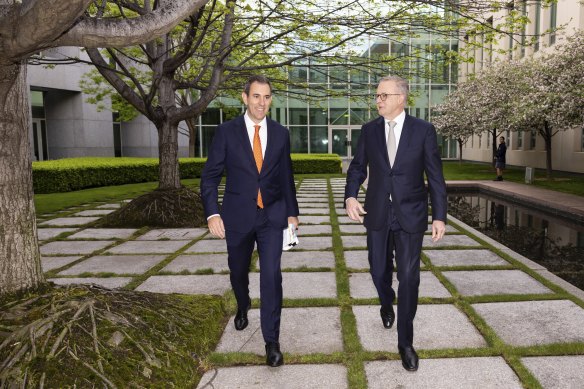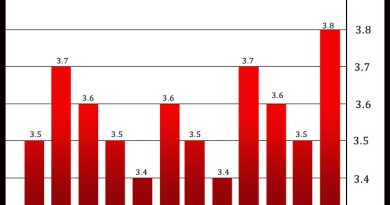Who knew? The price of better government is higher taxes
Have you noticed? Since the change of government, the politicians have become a lot franker about the budgetary facts of life. And now the Parliamentary Budget Office has spelt it out: it’s likely that taxes will just keep rising over the next 10 years.
The great temptation for politicians of all colours is to make sure we don’t join the budgetary dots. On one hand, they’re going to improve childcare and health and education, do a better job on aged care and various other things. On the other, they’ll cut taxes.
Treasurer Dr Jim Chalmers and Prime Minister Anthony Albanese will have to consider rejigging upcoming tax cuts. Credit:Alex Ellinghausen
In short, they’ve discovered a way to make two and two add to three.
The attraction of that relatively new institution, the Parliamentary Budget Office, is that it reports to the Parliament, meaning it’s independent of the elected government. Each year, sometime after the government has produced its budget, the office takes the decisions and figurings and examines whether they are sustainable over the “medium term” – an econocrats’ term for the next 10 years.
They do this by accepting the government’s present policies and mechanically projecting them forward for a further six years beyond the budget’s published figures for the budget year and the following three financial years of “forward estimates”.
Note that these mechanical projections are just projections – just arithmetic. They’re not forecasts of what will happen. No one but God knows what will happen to the economy over the next year, let alone the next 10.
No one putting together the Morrison government’s pre-election budget of April 2019 – the one saying the budget would soon be “back in black” – foresaw that the arrival of a pandemic 11 months later would knock it out of the ballpark, for instance.
Projections don’t attempt to forecast what will happen. Rather, they move the budget figures forward based on plausible assumptions about what the key economic variables – population growth, inflation, for instance – may average over the projection period.
So, projections are not what will happen, but what might happen if the government left its present policies unchanged for 10 years. They give us an idea of what changes in policy are likely to be needed.
Media reporting of the budget office’s latest medium-term projections focused on its finding that, if there are no further tax cuts beyond the stage three cuts legislated for July 2024, the government’s collections of personal income tax may have risen 76 per cent by 2032-33.
The average rate of income tax paid by all taxpayers is projected to reach 25.5 cents in the dollar before the stage three tax cut drops it to 24.1 cents. But then it could have risen to 26.4 cents by 2032-33 – which would be an all-time high.
Why? Bracket creep. Income is taxed in slices, with the slices taxed at progressively higher rates. So, as income rises over time, a higher proportion of it is taxed at higher rates, thus pushing up the average rate of tax on all the slices.
Like the sound of that? No. Which is why the media gave it so much prominence. But there’s much more to be understood about that prospect before you start writing angry letters to your MP.
The first is that, according to the projections, even with such unrestrained growth in income tax collections, the rise in total government revenue wouldn’t be sufficient to stop the budget deficit growing a bit, year after year.
Why not? Because of the strong projected growth in government spending. That’s the first thing to register: the reason tax collections are likely to rise so strongly is that government spending is expected to rise so strongly.
Why? Because that’s what we want. The pollies know we want more and better government services – which is why no election passes without both sides promising to increase spending on this bauble and that.
What neither side ever does in an election campaign is present the bill: “we’re happy to spend more on your favourite causes but, naturally, you’ll have to pay more tax to cover it”. Indeed, they often rustle up a small tax cut to give you the opposite impression: that taxes can go down while spending goes up.
The budget office’s projections suggest that total government spending will rise from 26.2 per cent of gross domestic product in the present financial year to 27.3 per cent in 2032-33. This may not seem much, but it’s huge.
Nominal GDP – the dollar value of the nation’s total production of goods and services, and hence, the nation’s income – grows each year in line with population growth, inflation and any real increase in our average standard of living. So, for government spending to rise relative to GDP, it must be growing faster even than the economy is growing.
Briefly, the spending growth is explained by continuing strong growth in spending on the National Disability Insurance Scheme, the growing interest bill on the government’s debt, and the rising cost of aged care.
This being so, there seems little doubt we’ll be paying a bit more tax – a higher proportion of our income – most years over the coming 10, and probably long after that.
But that’s not to say things will pan out in the way described by the budget office and as trumpeted by the media. For a start, it’s unlikely any government would go for six years without a tax cut.
It’s true that governments of both colours rely heavily on bracket creep – aka “the secret tax of inflation” – to square the circles they describe during election campaigns; to ensure two and two still add up to four.
But they’re not so stupid as never to show themselves going through the motions of awarding a modest tax cut every so often – confident in the knowledge that continuing bracket creep will claw it back soon enough.
The next point is that the overall average tax rates the budget office quotes are potentially misleading. Every individual taxpayer has their own average rate of tax, with high income-earners having a much higher average than people with low incomes.
But when the budget office works out the average for all taxpayers – the average of all the averages, so to speak – you get a number that accurately described the position of surprisingly few people. It’s like the joke about the statistician who, with his head in the oven and his feet in the fridge, said that, on average, he was perfectly comfortable.
There are plenty of things a government could do to reduce the tax concessions for high income-earners (like me) and to slant any tax cuts in favour of people in the bottom half, which would allow it to raise much the same revenue as the budget office envisages without raising the average tax rate paid by the average (that is, the median) individual taxpayer by nearly as much as the budget office’s figures suggest.
Fearless prediction: just such thinking will be what leads the Albanese government to make a start next year by rejigging the size and shape of the stage three tax cuts.
The Business Briefing newsletter delivers major stories, exclusive coverage and expert opinion. Sign up to get it every weekday morning.
Most Viewed in Business
From our partners
Source: Read Full Article



